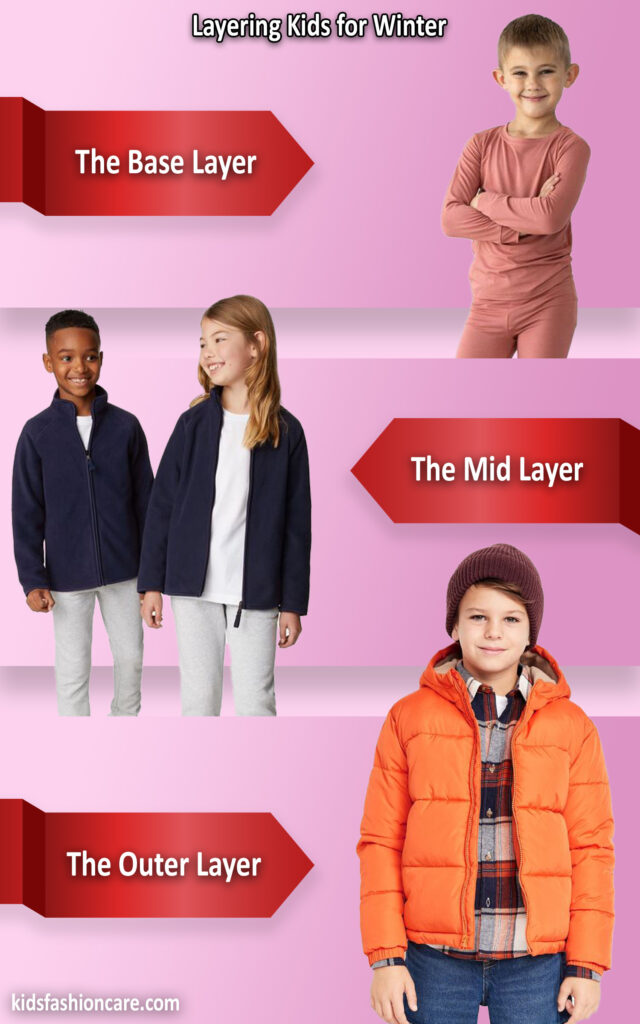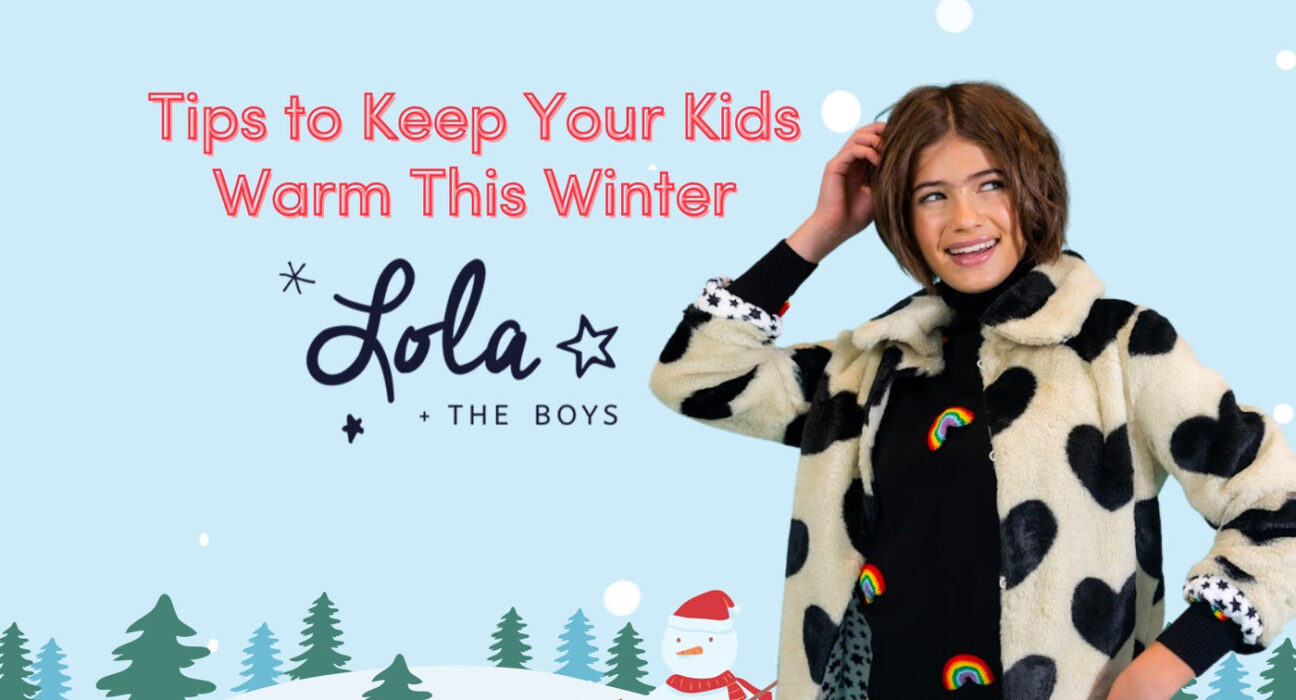Keeping kids warm in winter can be a challenge. The right clothing can make a big difference.
As temperatures drop, parents often worry about their little ones staying cozy. Layering is an effective way to protect against the cold. It allows for warmth, comfort, and flexibility. Each layer serves a purpose, from trapping heat to wicking moisture.
Understanding how to layer effectively can help you dress your kids properly for winter activities. Whether they are playing outside or heading to school, the right layers can keep them warm and happy. This guide offers practical tips on how to layer clothing for your children. Let’s explore easy ways to ensure they stay snug all season long.
Table of Contents
Introduction To Winter Layering For Kids
Winter can be tough for kids. Cold weather demands proper clothing. Layering is a smart way to keep children warm. It helps trap heat and allows for easy adjustments. Understanding how to layer effectively is key to a comfortable winter.
Importance Of Staying Warm
Staying warm in winter is vital for kids. Cold temperatures can lead to health issues. Here are some reasons why warmth matters:
- Prevents hypothermia and frostbite.
- Improves comfort during outdoor activities.
- Boosts overall mood and energy levels.
Warm children are happy children. They enjoy playing outside without discomfort. Proper layering helps achieve this.
Benefits Of Proper Layering
Layering offers several advantages. It allows for easy temperature control. Here are key benefits:
- Flexibility: Add or remove layers as needed.
- Insulation: Traps warmth between layers.
- Moisture management: Wicks sweat away from the body.
Layering also helps with changing weather. A sunny day can turn cold quickly. Being prepared keeps kids comfortable and safe.
| Layer Type | Function |
|---|---|
| Base Layer | Keeps moisture away from the skin. |
| Middle Layer | Provides insulation for warmth. |
| Outer Layer | Protects from wind and moisture. |
Understanding these layers will help parents dress their kids wisely. A thoughtful approach to winter layering makes a big difference.
Essential Layers Explained
Keeping your kids warm this winter is all about layering. Each layer serves a purpose. The right layers trap heat and block cold. Understanding these layers helps you dress your kids properly.
Let’s break down the essential layers. We will look at base layers and insulating layers. Each layer plays an important role in warmth and comfort.
Base Layers: The Foundation
Base layers are the first thing your kids wear. They sit directly on the skin. These layers are made from materials like moisture-wicking fabric. This helps keep sweat away. Dry skin stays warm. Choose long-sleeve tops and long johns for full coverage.
Look for snug-fitting base layers. Loose fabric can trap cold air. Avoid cotton, as it absorbs moisture. Instead, opt for materials like polyester or merino wool. These fabrics keep kids dry and warm.
Insulating Layers: Retaining Heat
Insulating layers are next. Their job is to keep the warmth in. These layers trap heat close to the body. Fleece jackets or down vests work well here. They provide warmth without adding too much bulk.
Choose insulating layers that fit comfortably. They should allow movement. Avoid thick layers that restrict activity. Layering with a mid-weight fleece is often best. It keeps kids warm without overheating.
Remember, layering is key. Proper layers help your kids stay warm and happy. A little planning goes a long way in winter comfort.
Choosing The Right Fabrics
Choosing the right fabrics is key to keeping kids warm this winter. Fabrics affect warmth, comfort, and breathability. Let’s explore two popular fabric types.
Merino Wool Vs. Synthetic
Merino wool and synthetic fabrics each have unique benefits. Knowing these can help you make the best choice.
| Fabric Type | Pros | Cons |
|---|---|---|
| Merino Wool |
|
|
| Synthetic |
|
|
Understanding Fabric Weights
Fabric weight affects warmth and comfort. Heavier fabrics trap more heat. Lighter fabrics are better for active play.
Here are common fabric weights:
- Lightweight (up to 150 g/m²): Great for layering.
- Medium weight (150-300 g/m²): Good for everyday wear.
- Heavyweight (300 g/m² and up): Best for extreme cold.
Choose the right fabric weight based on your child’s activity. Layering is essential. Start with a lightweight base layer. Add a medium layer for warmth. Finish with a heavy outer layer for wind and snow protection.
The Outer Shell: Protection From The Elements
Keeping kids warm starts with the right outer shell. This layer protects against wind, rain, and snow. Choose wisely to ensure comfort and safety. A good outer shell keeps moisture out and warmth in. Let’s explore key features of this essential layer.
Waterproof Vs. Water-resistant
Understanding the difference is crucial. Waterproof means no water gets in. It stands strong against heavy rain and snow. Water-resistant offers some protection. It can handle light rain but not heavy downpours.
For active kids, waterproof gear is best. They play hard and need reliable protection. Look for jackets with sealed seams and waterproof ratings. These features ensure dryness and comfort.
Breathability Matters
Breathability is key for active children. It allows sweat to escape while keeping warmth inside. A breathable outer shell prevents overheating. Look for materials that offer ventilation.
Some jackets have mesh lining or vents. These features help regulate body temperature. A comfortable child stays warm longer. Focus on finding a balance between warmth and breathability.
Accessorizing For Warmth
Winter can be harsh. Keeping kids warm is essential. Accessories play a key role. They add extra warmth and comfort. Here are some tips on how to layer effectively.
Hats And Scarves Essentials
Hats and scarves are must-haves for cold weather. They protect sensitive areas like the head and neck.
- Choose the Right Material: Wool or fleece provides warmth.
- Fit Matters: Make sure hats cover the ears.
- Fun Designs: Kids love colorful patterns.
Scarves should be long enough to wrap around the neck twice. This adds extra insulation. Look for scarves made of soft, warm fabrics.
Gloves And Mittens: A Comparison
Gloves and mittens serve different purposes. Understanding their benefits helps in choosing the right one.
| Type | Warmth | Finger Movement | Best For |
|---|---|---|---|
| Gloves | Less warm | High | Activities needing dexterity |
| Mittens | More warm | Low | Playing in snow |
Choose gloves for outdoor activities. Opt for mittens for playing in the snow. Both should be waterproof.
Footwear Considerations
Choosing the right footwear is key for kids in winter. Warm and dry feet keep kids happy. Good boots protect against cold and wet conditions. Let’s explore how to choose the best options.
Keeping Toes Toasty
Start with insulated boots. Look for materials that trap heat. Fleece-lined boots are a great choice. They keep toes warm during playtime.
Check for waterproof options. Wet feet can lead to chills. Waterproof boots help keep moisture out. This keeps kids comfortable while they explore.
Balancing Warmth And Traction
Good traction is important for safety. Kids love to run and play. Choose boots with non-slip soles. This helps prevent slips on icy surfaces.
Consider the weight of the boots. Heavy boots can tire little feet. Lightweight options are easier for kids to wear. Balance warmth with ease of movement.
Layering For Different Activities
Winter is here. Keeping kids warm during different activities is key. Layering helps manage body heat. It allows kids to stay comfortable whether they play hard or relax.
Active Play Vs. Quiet Time
Kids are full of energy. They often switch between active play and quiet time. Each activity needs a different approach to layering.
- Active Play: Choose breathable layers. Base layers should wick moisture. Fleece or insulated jackets work well. Add a waterproof outer layer for snow or rain.
- Quiet Time: Use cozy layers. A warm sweatshirt or sweater is great. Soft blankets can keep them warm indoors. Avoid too many layers to prevent overheating.
Here’s a simple table to compare layers:
| Activity | Recommended Layers |
|---|---|
| Active Play | Base Layer, Insulated Jacket, Waterproof Outer Layer |
| Quiet Time | Base Layer, Sweatshirt, Soft Blanket |
Adjusting Layers On-the-go
Flexibility is important. Kids move around. Layers should be easy to adjust. Here are some tips:
- Zip Up or Down: Choose jackets with zippers. It’s easy to open for warmth.
- Removable Layers: Use vests or light jackets. Kids can take them off when they warm up.
- Wearable Blankets: Consider a wearable blanket for quiet time. It’s easy to move in.
Check for comfort regularly. Ask your child if they feel too hot or cold. Adjust their layers as needed. This keeps them happy and active.
Age-appropriate Layering
Keeping kids warm in winter requires age-appropriate layering. Different age groups need different strategies. Toddlers, school-aged children, and teens all have unique needs. Understanding these differences helps parents dress their kids properly. Let’s explore how to layer for each age group.
Toddlers Vs. School-aged Children
Toddlers and school-aged children have different needs for warmth. Toddlers may need more help getting dressed. They are active but can’t always tell you when they are cold. School-aged children can dress themselves but may resist wearing extra layers.
| Age Group | Layering Tips |
|---|---|
| Toddlers |
|
| School-Aged Children |
|
Teens: A Unique Approach
Teens often prioritize style over warmth. They may choose trendy outfits. Parents need to guide them towards practical choices. Layering can help them stay warm without sacrificing style.
- Base Layer: Long-sleeve tops and leggings.
- Middle Layer: Hoodies or stylish sweaters.
- Outer Layer: Trendy jackets that are also warm.
Encourage teens to pick layers they enjoy. This keeps them warm and comfortable. Let them express their style while staying cozy.
Dressing For Extreme Cold
Winter can be harsh, especially for children. Keeping them warm is essential. The right clothes make all the difference. Layering is key for extreme cold. It traps heat and blocks the wind. Let’s explore how to dress kids properly.
Specialized Gear For Frigid Temperatures
Invest in high-quality winter gear. Look for insulated jackets. These jackets should be thick and waterproof. Choose snow pants that are warm and durable. They protect against snow and cold. Don’t forget insulated gloves and hats. They keep hands and heads warm. Consider thermal socks for extra warmth. Boots should be waterproof with good insulation.
Layering is important. Start with a moisture-wicking base layer. This helps keep kids dry. Add an insulating layer for warmth. Fleece is a great choice. Finally, use a waterproof outer layer. This protects against wind and snow.
Safety Tips In Sub-zero Weather
Monitor your child’s time outdoors. Limit playtime in extreme cold. Watch for signs of frostbite. Red or pale skin may indicate frostbite. Keep an eye out for shivering. This is a sign to go indoors. Dress in multiple layers. This helps regulate body temperature.
Encourage breaks indoors. Warm drinks can help kids regain heat. Teach them to stay dry. Wet clothes can lead to chill quickly. Always check the weather before heading out. Be prepared for sudden changes.
Avoiding Overheating
Keeping kids warm in winter is important. However, too many layers can cause overheating. It is crucial to find a balance. Knowing how to recognize overheating is key. Use the tips below to help your child stay comfortable.
Recognizing Signs Of Overheating
Look for these signs of overheating:
- Flushed Skin: Red cheeks or forehead.
- Excessive Sweating: Clothes may feel damp.
- Rapid Breathing: Breaths become quick and shallow.
- Complaints of Discomfort: Kids may say they feel too hot.
- Restlessness: They may fidget or want to remove layers.
How To Quickly Cool Down
If your child shows signs of overheating, act fast:
- Remove Layers: Take off one or two layers of clothing.
- Find a Cooler Spot: Move to a shaded or indoor area.
- Hydrate: Give them water to help cool down.
- Encourage Deep Breathing: Help them relax and breathe slowly.
Monitor their temperature closely. Keeping kids warm is essential, but comfort matters too.
Layering On A Budget
Winter can be tough on your wallet. Keeping kids warm shouldn’t break the bank. Layering is a smart way to stay cozy without spending too much. Here are some tips to help you layer your kids for winter while staying on budget.
Affordable Layering Options
Look for these affordable options for your kids:
- Thrift Stores: Great for finding warm clothes at low prices.
- Hand-Me-Downs: Ask friends or family for clothes their kids outgrew.
- Sales and Clearance: Shop during sales to save money.
- Mix and Match: Use clothes your kids already own.
- Basic Layers: Invest in plain thermal shirts and leggings.
Diy Warmth Hacks
Get creative with these DIY tips:
- Repurpose Old Clothes: Cut and sew old sweaters into vests.
- Fleece Liners: Use fleece fabric as extra layers under jackets.
- Warm Scarves: Wrap old blankets around their necks for extra warmth.
- Homemade Hand Warmers: Fill small fabric pouches with rice. Heat them in the microwave.
- Socks on Hands: Use thick socks as mittens in a pinch.
These tips help keep your kids warm without overspending. Enjoy the winter while staying cozy!

Credit: ellaswool.com
Care And Maintenance Of Winter Clothing
Keeping your kids warm this winter means caring for their clothing. Proper maintenance helps layers last longer. Clean and store them correctly to avoid damage. This keeps your children comfortable and cozy throughout the season.
Cleaning And Storing Winter Gear
Start by checking labels on winter clothing. Follow washing instructions closely. Most winter gear can be machine washed. Use cold water and a gentle cycle. Avoid using fabric softeners as they can reduce insulation.
After washing, air-dry the clothes if possible. This helps maintain their shape. If you must use a dryer, choose a low heat setting. Remove items promptly to prevent wrinkles.
Store winter gear in a cool, dry place. Use breathable bags to avoid moisture build-up. Keep items away from direct sunlight. This prevents fading and damage to fabrics.
Extending The Life Of Your Layers
Check your kids’ winter clothes regularly. Look for signs of wear and tear. Fix any small damages before they get worse. Sew up loose seams and patch any holes.
Teach kids to take care of their clothing. Encourage them to hang up wet gear. This prevents mold and mildew. Make it a habit to remove snow and mud right away.
Invest in quality winter clothing. Good materials last longer and perform better. Choose items that are easy to clean and maintain.

Credit: www.kidsfashioncare.com
Conclusion: Embracing Winter With Warmth
Winter brings joy and fun. Keeping kids warm is key. Layering is the best way. Let’s review some effective strategies.
Recap Of Layering Strategies
Layering helps trap heat and block cold. Here’s a quick recap:
- Base Layer: Choose moisture-wicking materials. These keep kids dry.
- Middle Layer: Use insulating fabrics like fleece. They provide warmth.
- Outer Layer: Select windproof and waterproof jackets. Protect against the elements.
- Accessories: Don’t forget hats, gloves, and scarves. They keep extremities warm.
Mix and match these layers. Adjust based on the weather and activities. Kids should feel cozy and comfortable.
Encouraging Outdoor Play
Winter is perfect for outdoor fun. Encourage kids to play outside. Here are some ideas:
- Build a snowman.
- Have a snowball fight.
- Go sledding.
- Try ice skating.
Outdoor play boosts health and happiness. Warm layers make it possible. Kids can enjoy winter while staying warm.
Embrace winter. Make it a season of fun and warmth.

Credit: brighterfuturesindiana.org
Frequently Asked Questions
What Are The Best Layers For Kids In Winter?
Start with a moisture-wicking base layer. Add an insulating layer like fleece. Finish with a waterproof outer layer.
How Do I Keep My Kids Warm Without Overheating?
Choose breathable fabrics. Dress them in lighter layers. Remove layers if they feel too warm.
How Many Layers Should My Child Wear In Winter?
Generally, three layers work well. A base, an insulating, and a protective layer keep them warm.
What Materials Are Best For Kids’ Winter Clothing?
Look for wool, fleece, and synthetic materials. They provide warmth and wick away moisture effectively.
Conclusion
Keeping your kids warm this winter is important. Layering clothes helps trap heat. Choose soft, comfortable fabrics for their skin. Always check the weather before dressing them. Make sure they can move easily in their layers. Encourage them to wear hats and gloves.
Teach them the value of staying warm. With these tips, your kids can enjoy winter activities. Dress them right, and they will stay cozy all season long. Let’s make this winter fun and warm for everyone.







